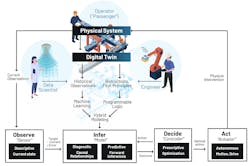Artificial intelligence (AI) is just getting started revolutionizing manufacturing
With ChatGPT and generative artificial intelligence (AI) moving into white-collar work, suddenly, it’s the biggest discussion topic in the world. Congressional hearings, dozens of front-page stories in newspapers, nightly discussions on every cable news channel – the world is suddenly realizing that AI is a massive disruptive force.
With manufacturing so ahead of the rest of the world in AI awareness and experience, it would be easy to ignore the latest wave of news as hype, but Mithun Nagabhairava, senior manager of Rockwell Automation’s Kalypso business, says AI isn’t close to being done with revolutionizing manufacturing. The gains to date are just a start.
Smart Industry discussed the state of AI’s art, where it’s having the most impact and what’s next.
Smart Industry: How advancements in AI/ML are creating new frontiers in industrial manufacturing?
Mithun Nagabhairava: These state-of-the-art technologies are revolutionizing the way factories operate, unlocking unprecedented levels of efficiency, productivity and quality. From AI-enabled decision-making systems that empower the evolving workforce to autonomous systems optimizing operations, AI/ML is spearheading a new era in manufacturing. Notably, AI is playing a pivotal role in advancing the automation to autonomy for industrial manufacturers, akin to the transformative impact autonomous vehicles have changed the automotive realm.
SI: What advancements are we talking about? New tools? New techniques?
MN: The advancements we find particularly compelling are those that synergize the power of AI/ML with the well-established bedrock of optimal control theory. Originating in the 18th century, the optimal control theory has evolved over centuries, aligning well with the deterministic nature of manufacturing processes.
Innovative AI/ML technologies, high-power compute infrastructure and cost-effective large scale data capture are helping to solve more complex manufacturing challenges involving multi-variable, non-linear and time dynamics, driving innovations at a scale that was never possible before.
By processing and analyzing vast datasets, AI/ML algorithms help to derive analytical models that describe the historical behavior of the system under changing environments and determine the best possible action to take for manufacturers to improve asset availability, optimize operations, enhance quality control and reduce energy usage.
Here are a few notable advancements:
- Autonomous control: Leveraging AI/ML, manufacturing processes are transitioning from automated to autonomous, enabling systems to make real-time decisions and adjustments without human intervention.
- Machine vision systems: Combining advanced closed-loop control strategies with advanced sensory machine vision AI feedback, enables PLCs to take automatic corrective actions to minimize defects in real time.
- Evolutionary modeling: In the early days of data science practices, single-point solutions were the norm, where a single model was chosen based on assorted criteria derived from the available data. This approach then evolved into constructing models from an ensemble of potential candidate models. Evolutionary models are emerging where a population of models engages in direct competition—either iteratively or in an adversarial nature. This approach requires each model to adapt successfully with every iteration to survive, resulting in the development of highly accurate and robust models that are more in-tune with the actual physics of the process and respective system dynamics.
SI: In what fields/verticals are these most prominent?
MN: The advancements in AI/ML, combined with the principles of optimal control theory, are proving transformative across process, hybrid and discrete manufacturing industries.
- Consumer packaged goods manufacturing: Within food, beverage and pulp and paper manufacturing, incoming raw material variability is a common concern, often leading to unpredictable product and machine performance issues. Moreover, the plant’s environmental conditions significantly influence the raw material properties, which complicates the process even further. Traditionally, operators and engineers have utilized trial-and-error methods to solve these types of issues. Although sometimes successful, this approach is time-consuming, highly dependent upon institutional knowledge and not standardized, leading to varying scrap and throughput rates. Leveraging autonomous control strategies, we were able to build reliable models that combined operator knowledge with learnings derived from historical data to determine how the system would need to be adjusted for optimal outcomes.
- Tire manufacturing: With hundreds of material compositions, intricate compound interactions and stringent quality control requirements at every step, variations in raw materials, production conditions and rheological properties across the overall process can lead to inconsistencies in tire quality. Enabled by the advancements in AI/ML, leading tire manufacturers are overcoming these challenges by leveraging advanced closed-loop optimization and machine vision capabilities to optimize production processes. These include developing process models and optimization capabilities to achieve optimal Mooney viscosity at mixing, consistent weight measurements closer to the setpoint at extrusion, reducing out-of-tolerance events at tire building machines, optimal vulcanization properties at curing and automated defect detection at final inspection.
- Medical device manufacturing: Preventing contamination throughout the entire production process and achieving uniformity in each final product are two significant challenges. Machine vision provides new avenues to guarantee the certificate of conformance (COC), incorporating capabilities for precise metrology and defect detection by leveraging 2D/3D imaging systems combined and deep-learning convolutional neural network (CNN) models. These capabilities enable a high degree of automation, empowering manufacturers to operate within completely closed environments. This approach eliminates stages that require contact by human operators, which are traditionally the primary source of contamination. In addition, advances in AI technologies have enabled more precise and accurate robotic motions, which when paired with advanced machine vision capabilities maximize throughput and uniformity of devices to drive significant business value.
SI: What are the benefits of automatically capturing OT context at the source and using AI to create valuable insights with IT/OT convergence? How does this work?
MN: Leveraging AI to analyze OT context, captured automatically at the source and paired with IT information, uncovers an optimal synergy between distributed and tactical decision-making at the OT level, alongside centralized and strategic planning at the IT level. This insight empowers organizations to achieve an IT/OT convergence that maximizes value and efficiency.
Consider conveyance systems that combine material streams from multiple sources and then distribute those same materials to multiple workstations or machinery, often with bypasses between each major sections to ensure the overall balance of materials. While the OT control system on each of these major conveyance sections is well-equipped to tactically adjust the speed within the section to ensure a constant stream of material, it lacks awareness of the IT data orchestrating the material inflow into each section, staffing the workforce or loading the machines fed by the conveyance. By combining this IT data with OT data regarding the current inventory level of each major convenance section, AI can prescribe effective operation of bypasses between the major sections to alleviating bottlenecks, create more consistent outflows and adjust for planned input imbalances.
SI: What tips can you offer for enterprises to manage the ML model operations cycle end-to-end (from model creation to maintenance)? Is this as tricky as it sounds?
MN: The increasing prevalence of AI/ML technologies, and the growing complexity of integrating machine learning models into critical manufacturing processes, prompted the development of MLOps to efficiently manage the entire lifecycle of these models, from inception to maintenance.
Capitalize on the robust foundation already established through experience within the OT systems. OT systems in factories have often matured over extended periods, and to a large extent have organized the association and contextualization of information. Ensuring that the I/O architecture of the OT system is mapped to a ML model at the time of creation jump starts path to value. Aligning the OT context with a ML model will afford economies to expand and maintain these capabilities post-deployment. This foundational practice will act as a catalyst, accelerating AI/ML initiatives.
Integrating the MLOps methodology as a natural extension of well-established OT practices for monitoring and maintaining model and machine performance, aligning with well-established change management and the standard operating procedures, is pivotal for the adoption of these practices. Scaling of these capabilities should align with the business value, encompassing the number of deployed ML models in the production environment, measuring their impact on business ROI and gauging the ongoing maintenance efforts.
SI: What are tips for launching ML solutions with minimal effort from data scientists using pre-built ML libraries and bring-your-own-models (BYOM)?
MN: Minimizing effort from data scientists involves important organizational and technological considerations. On the organizational front, the most important aspect is incorporating process experts or operators into the overall modeling process, spanning from creation to deployment. Often for an ML solution to be used in a plant setting, the AI-prescribed solution must be validated or approved by an expert in the operation of a process. Ensuring that a model has a chance for deployment often involves understanding the historical operation principles and ensuring that the AI results can be explained within this context. In addition, proper organizational involvement can ensure that ML activities are keenly focused to prioritize decisions that drive tangible value while approximating or disregarding less impactful process aspects.
Imagine renovating your house with the guidance of a contractor who involves you from the initial planning stages to the final touches. Similarly, launching ML solutions with minimal effort involves collaboration between data scientists and process experts. This ensures AI solutions fit into operations.
Regarding technologies, adopting platforms that seamlessly accommodate bring-your-own-models (BYOM) greatly simplifies deployment, specifically the OT models that have been developed and matured over time. These platforms provide the ability to fine-tune the model parameters to match the specific equipment and product characteristics, such as temperatures, pressures, motor speeds, etc. It’s important to select the technology stack that provides easy-to-configure standard connectivity protocols to communicate with PLCs and IT business systems, flexibility to package key capabilities as microservices to decouple resilient components, and in-built functionality to establish workflow pipelines streamlining the deployment and maintenance at scale.
SI: What does this trend look like in five years? Twenty years?
MN: According to the latest market reports, the global industrial AI market was a $16.9 billion market in 2020 and is expected to reach $102.2 billion by 2026. As we envision the trajectory of this trend, it becomes increasingly evident that AI/ML will revolutionize the industrial manufacturing processes and unleash unprecedented levels of business outcomes over the next five and ten years.
- Wide adoption of autonomous manufacturing: AI/ML technologies will drive the widespread adoption of autonomous capabilities, where every automation controller will be equipped with intelligent AI agents to achieve superior levels of control and optimize manufacturing processes.
- Shaping the next-generation workforce: AI-enabled autonomous capabilities will become central for enterprises to retaining decades of tribal knowledge from the retiring workforce and shaping the workforce of the future.
- Empowering operator 2.0: AI will be pivotal to elevating the role of an operator from making repetitive manipulations to managing the performance of the machines.
- Enhancing quality control with machine vision: Combining advanced closed-loop control strategies with machine vision feedback at every critical step of the manufacturing process, enables PLCs to take automatic corrective actions to minimize defects in real time, leading to superior levels of product quality that were previously unattainable.
- Advancing vision-guided robotics: Advanced perception capabilities with fixed robotic systems (such as articulated robotic arms, delta robots and gantry systems) and mobile robotic platforms (like AGVs and AMRs) enables them to navigate complex environments, determine optimal paths for routing, handle delicate materials and perform intricate tasks with precision.
- Adoption of generative AI to accelerate time-to-value: This innovative form of AI will revolutionize manufacturing by generating synthetic data for data augmentation and training robust AI/ML models at a rapid pace, driving tremendous innovation.
- Reinforcement learning (RL) with human feedback: These capabilities combine the decision-making abilities of RL algorithms with the expertise and intuition of human operators for a new era of intelligent systems that continuously learn and evolve with human guidance.
- Energy optimization: AI will play a pivotal role in effectively optimizing energy usage and reducing costs, while maximizing the throughput and quality of energy-intensive processes.
The successful development and adoption of AI systems in manufacturing will be contingent on deep industry expertise and the required application-specific knowledge. Companies that possess this expertise coupled with specialized knowledge in applying AI technology will emerge as pioneers in driving innovation, unlocking the full potential of AI systems and delivering transformative results in manufacturing operations.
How are these capabilities advancing your manufacturing processes and helping you develop strategic advantages over your competitors?
About the Author
Robert Schoenberger
Editor-in-Chief
Editor-in-Chief
LinkedIn: linkedin.com/in/robert-schoenberger-4326b810
Twitter: @Rschoenb
Bio: Robert Schoenberger has been writing about manufacturing technology in one form or another since the late 1990s. He began his career in newspapers in South Texas and has worked for The Clarion-Ledger in Jackson, Mississippi; The Courier-Journal in Louisville, Kentucky; and The Plain Dealer in Cleveland where he spent more than six years as the automotive reporter. In 2013, he launched Today's Motor Vehicles, a magazine focusing on design and manufacturing topics within the automotive and commercial truck worlds. He joined IndustryWeek in late 2021 and took on responsibility for Smart Industry in 2023.



